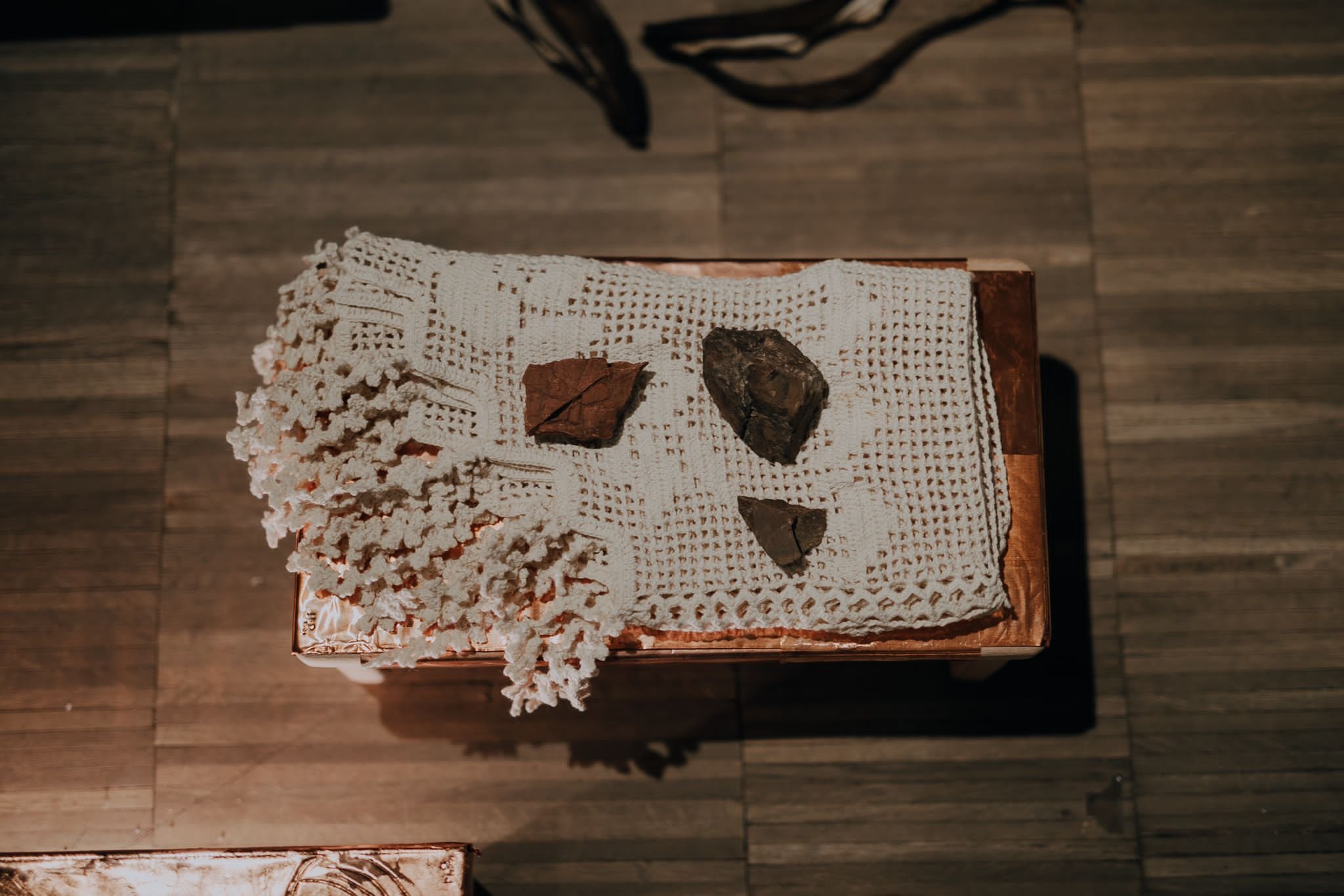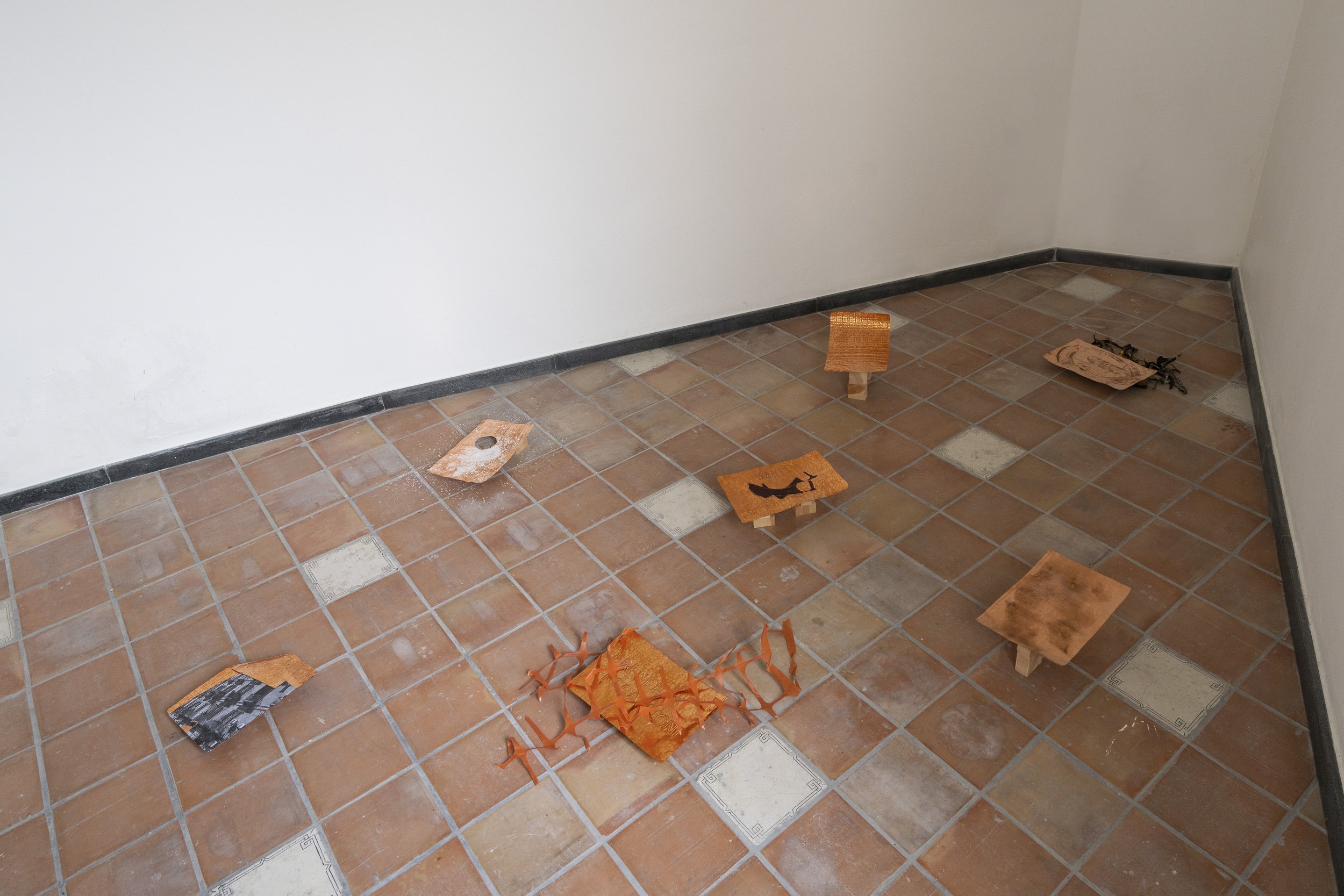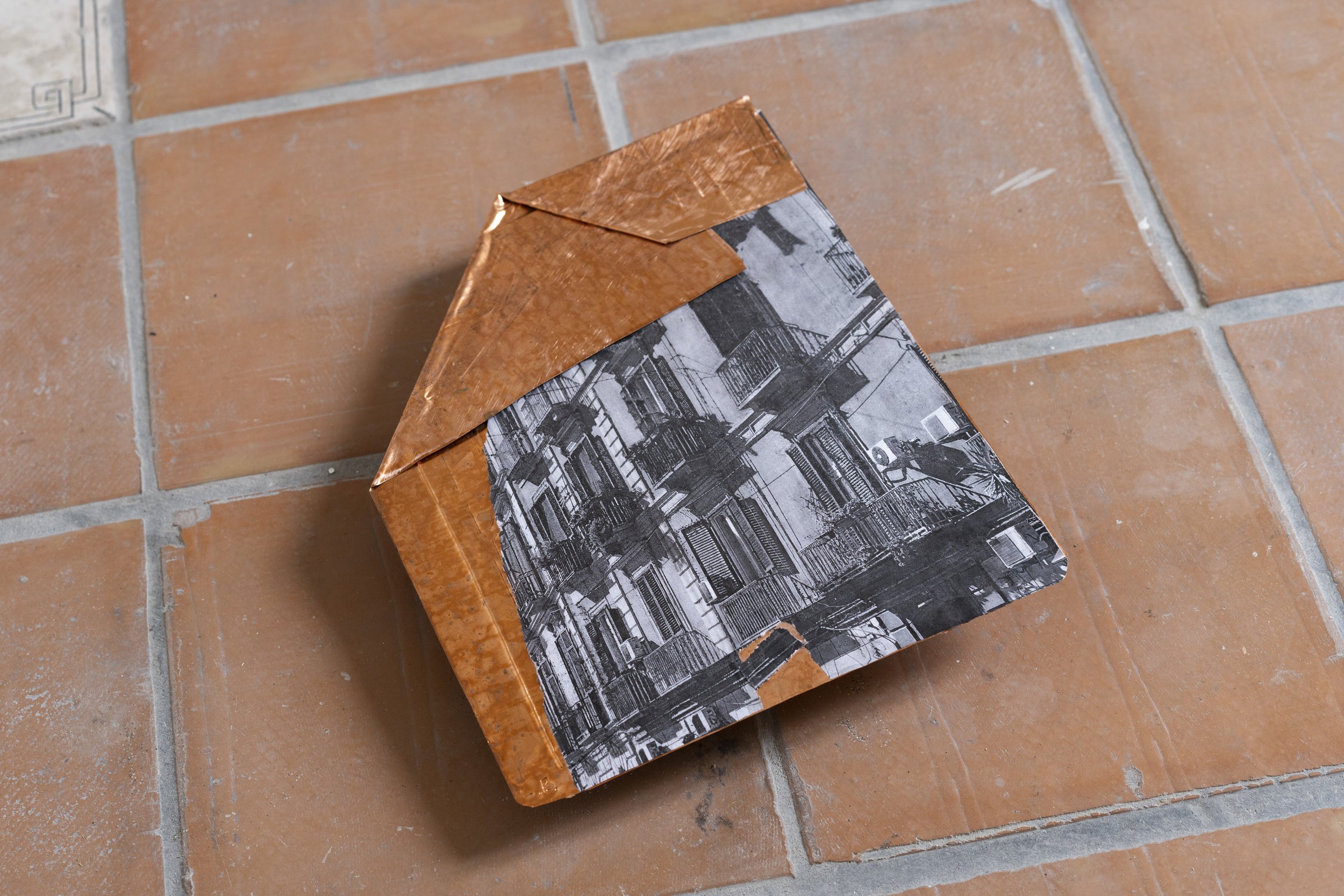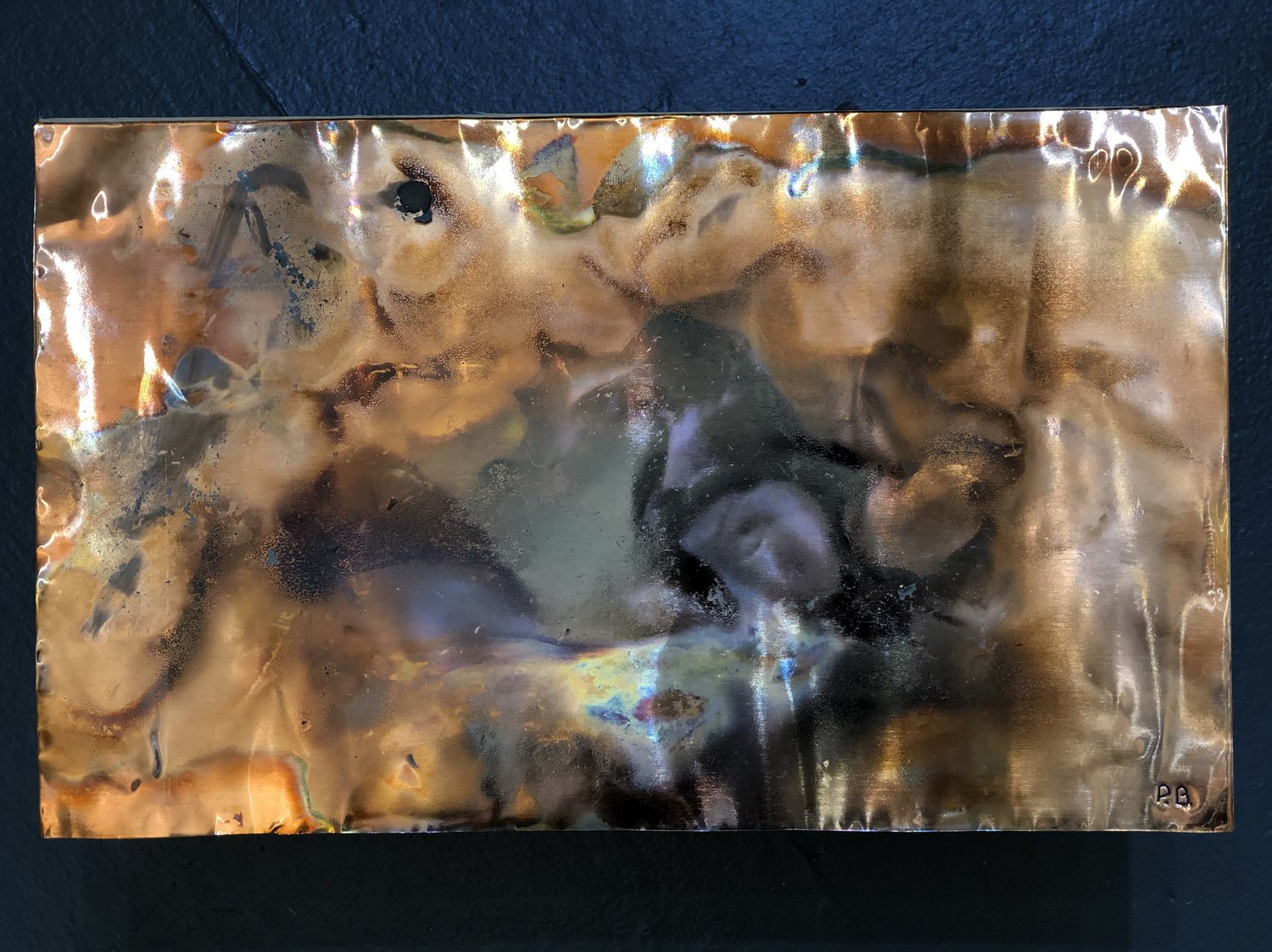… person, action, situation … Museo Nitsch, Napoli. Installing photo by: Amadeo Benestante.
Person, Action, Situation, a gentle rhyme, tackles the experience of shame, for which the artist has been gathering other people's stories about shame and attempting to blend them with his own experience so as to understand the prevailing social and cultural norms. The work’s rhythmic name, which evokes the power of repetition and persistence, echoes the artist's favorite theme to work with, shame, which he revisits frequently. For this series, Huo Rf forms copper–one of his most commonly employed materials–with writing, or combines it with objects such as a banana peel, plastic, or photo prints. His research also revolved around interviewing people and asking them three key questions: if they have any recollections of shame, if they are still ashamed of that time, and how they react when they see something "shameful." In some ways, sharing shame fosters a conversation in which those feelings might become political agents instead of simply subjects. Through these works, Huo Rf attempts to unite people around a very common feeling, while emphasizing how this shared emotion has affected identity building by defining the borders of the personal and public, and serves to reinforce the famous slogan, "personal is political."
Zehra Begüm Kışla, New York, 2024
… person, action, situation … emerged as a series that looks at the concept of “shame” individually, socially, ecologically, and politically and elaborates the concept as discussion/dialogue through portraits, which I aim to expand into a broader perspective over time.
As I looked at the concept of shame and thought about it, I began to see concretely that it varied a lot according to daily habits, professional practices, city-space, family, society, or physical/scientific/ecological awareness. I started exploring how the feeling of shame that one is trying to get rid of or formed as being unwanted is an individual struggle, how shame surrounds the person, how the society turns this feeling into an element of pressure, how and to what extent the tradition takes place in these experiences, at what stage the boundaries are noticed, the problems that emerge when the limits are removed and at the end what was left from the confrontation area. As I opened up about the shame that we suppressed the most and buried deep, I found in the answers to the three questions I asked for each work: why shame exists, where it came from, its source, how solid but invisible veil it is.
I asked the mentioned questions as follows;
Would you consider sharing something that you feel ashamed of if there's any?
If you had such an experience, do you still feel shame over it after you've shared it?
What are your common reactions when you come across something shameful?
I am continuing this series, which I started in a residency experience in 2019, with different portraits accompanied by the same questions, in Naples, where I came through the residency program of Fondazione Morra*. I engrave the answers about shame from art professionals with different experiences that allow me to connect with the city on copper sheets because of its temporality and conductive material. We can also physically touch these works that have turned into a place installation, and we can form stronger bonds by talking about our shame.
*The residency by Huo Rf at Fondazione Morra in Autumn 2021 is part of the program of cultural exchanges Neapolitan Dialogues designed by Vittorio Urbani for Fondazione Morra.
**With Turkey ONE Association’s kind support in partnership with Fondazione Morra.
Leeway exhibition installation view, Versus Art Project, photo by: Barış Özçetin.
‘N.B.’, 2024, wooden pedestal and soaps of various sizes produced at different dates on copper, 21 cm x 20 cm x 33 cm, unique.
Leeway exhibition installation view, Versus Art Project, photo by: Barış Özçetin.
‘F.Y.’, 2024, found objects from different dates and writing placed on copper, wooden pedestal, 13.5 cm x 19.5 cm x 34 cm, unique.
Leeway exhibition installation view, Versus Art Project, photo by: Barış Özçetin.
‘K.Ö.’, 2024, the artist’s father’s shirt, rope, and copper wire on a copper, wooden pedestal, 16 cm x 19.5 cm x 35.5 cm, unique.
Leeway exhibition installation view, Versus Art Project, photo by: Barış Özçetin.
‘E.C.’, 2024, drawing on copper, candles produced at different dates and in different sizes, wooden pedestal, 41 cm x 19.5 cm x 32 cm, unique.
Leeway exhibition installation view, Versus Art Project, photo by: Barış Özçetin.
Contemporary Istanbul Art Fair, Vision Art Platform, Istanbul, 2022.
… person, action, situation … , Erimtan Archaeology and Arts Museum, Ankara, Installing photo by: İstisnai İşler. 2022.
H.R., Drawing on copper and copper colored leaf on wooden pedestal, bulb lamp and porcelain lamp holder with 5 meters connecting cable under the senit pedestal. 13 cm x 21 cm x 34,5 cm. 2022. Produced with the support of Erimtan Archaeology and Arts Museum, photo by: İstisnai İşler.
H.R., copper, 10 bells of different ages and sizes, copper wire, copper nails, on a senit pedestal. 23.5 cm x 29 cm x 34 cm. 2022. Produced with the support of Erimtan Archaeology and Arts Museum, photo by: İstisnai İşler.
H.R., Copper and hand-knitted curtain by the artist's mother, three different weights of stones from Mersin-Gözne plateau, on a senit pedestal. 21 cm x 21 cm x 38 cm. 2022. Produced with the support of Erimtan Archaeology and Arts Museum, photo by: İstisnai İşler.
N.K., stone and burnt joss paper on copper, on senit pedestal, 21.5 cm x 17.5 cm x 32 cm. 2021. Produced with the support of Erimtan Archaeology and Arts Museum, photo by: İstisnai İşler.
… person, action, situation … Museo Nitsch, Napoli. Installing photo by: Amadeo Benestante. 2021.
… person, action, situation … , Museo Nitsch, Napoli. Installing photo by: Amadeo Benestante. 2021.
L.B., Drawing on copper and collage, on wooden pedestal. 13 cm x 21 cm x 34,5 cm. 2021. Produced with the support of Turkey ONE Association and Fondazione Morra. Photo by: Amadeo Benestante.
V.U., Drawing on copper, on wooden pedestal. 13 cm x 21 cm x 34,5 cm. 2021. Produced with the support of Turkey ONE Association and Fondazione Morra. Photo by: Amadeo Benestante.
A.R., (detail) Drawing on copper and salt on two wooden cubes. 13 cm x 21 cm x 34,5 cm. 2021. Produced with the support of Turkey ONE Association and Fondazione Morra. Photo by: Amadeo Benestante.
A.T., Drawing on copper, on wooden pedestal. 13 cm x 21 cm x 34,5 cm. 2021. Produced with the support of Turkey ONE Association and Fondazione Morra. Photo by: Amadeo Benestante.
M.W., (detail) Drawing on copper and and rotting banana peels on senit wooden pedestal. 13 cm x 21 cm x 34,5 cm. 2021. Produced with the support of Turkey ONE Association and Fondazione Morra. Photo by: Amadeo Benestante.
G.M., Drawing on copper and and plastic construction materials on senit wooden pedestal. 13 cm x 21 cm x 34,5 cm. 2021. Produced with the support of Turkey ONE Association and Fondazione Morra. Photo by: Amadeo Benestante.
S.Y., Drawing on copper, on wooden pedestal. 13 cm x 21 cm x 34,5 cm. 2021. Produced with the support of Turkey ONE Association and Fondazione Morra. Photo by: Amadeo Benestante.
SHAME: Shame is a discrete, basic emotion, described as a moral or social emotion that drives people to hide or deny their wrongdoings. The focus of shame is on the self or the individual with respect to a perceived audience. Empirical research demonstrates that it is dysfunctional for the individual and group level. Shame can also be described as an unpleasant self-conscious emotion that involves negative evaluation of the self. Shame can be a painful emotion that is seen as a "...comparison of the self's action with the self's standards..." but may equally stem from comparison of the self's state of being with the ideal social context's standard. Some scales measure shame to assess emotional states, whereas other shame scales are used to assess emotional traits or dispositions- shame proneness. "To shame" generally means to actively assign or communicate a state of shame to another person. Behaviors designed to "uncover" or "expose" others are sometimes used to place shame on the other person. Whereas, having shame means to maintain a sense of restraint against offending others (as with modesty, humility, and deference). In contrast to having shame is to have no shame; behave without the restraint to offend others, similar to other emotions like pride or hubris. (source: wikipedia)
SVA Summer Residency Programs Open Studio Exhibition, New York City, USA, Sep 2019,.
From left to right: M.F., Drawing on copper on wooden pedestal. 13 cm x 21 cm x 34,5 cm. 2019. - P., Drawing on copper on wooden pedestal. 13 cm x 21 cm x 34,5 cm. 2019. . - P., Drawing on copper on wooden pedestal. 13 cm x 21 cm x 34,5 cm. 2019. Produced with the support of the American Turkish Society.
J.I., Drawing on copper on wooden pedestal. 13 cm x 21 cm x 34,5 cm. 2019. Produced with the support of the American Turkish Society.
D.B., Drawing on copper on wooden pedestal. 13 cm x 21 cm x 34,5 cm. 2019. Produced with the support of the American Turkish Society.
P.B., Mixed media on copper, on wooden pedestal. 13 cm x 21 cm x 34,5 cm. 2019. Produced with the support of the American Turkish Society.
L.F., Drawing on copper on wooden pedestal. 13 cm x 21 cm x 34,5 cm. 2019. Produced with the support of the American Turkish Society.
Special thanks to: American Turkish Society, My mentors Dara Birnbaum, William Powhida and Media Farzin, all resident artists and SVA. Melek Gençer, Ferhan Gençer, Selim Bilen, Asena Doğan, Maxwell Chien, Joseph Imhauser, Peppermint, Lara Fresko, Fondazione Morra, Turkey ONE Association, Giuseppe Morra, Vittorio Urbani, Serra Yilmaz, Asad Raza, Alessandra Toroncone, Marta Wroblewska, Luca Di Bernardo, Hera Büyüktaşçiyan, Erimtan Archaeology and Arts Museum, Nihat Karataşlı, İz Öztat.






























